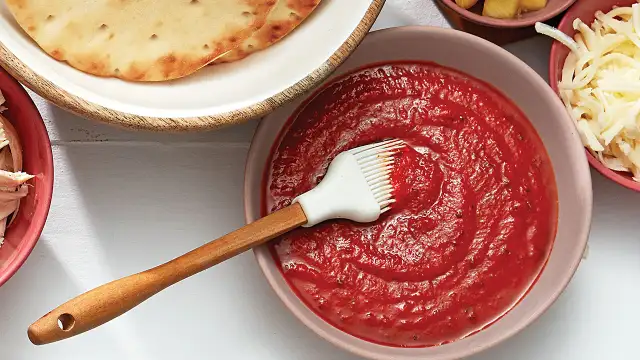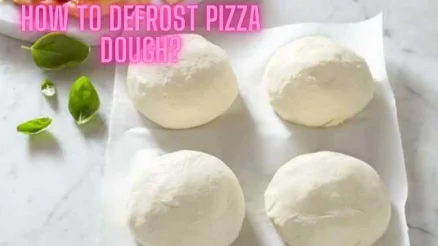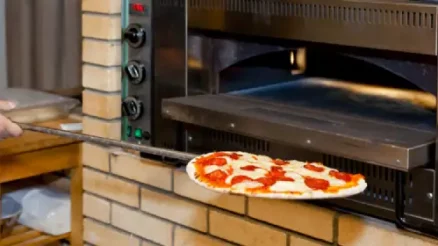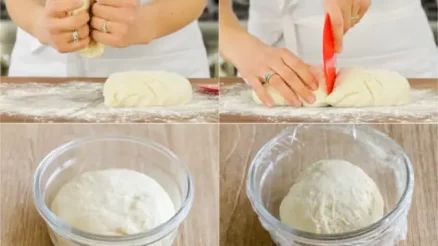Are you seeking for How to make pizza sauce?, if yes you are at the right place.
Making pizza sauce is easy to do at home. You can make it the traditional way, or you can take shortcuts that will still give you a great-tasting sauce in no time.
There are many different ways to make homemade pizza sauce, but they all have in common that they start with tomato paste and end up with something delicious!
The key to making your homemade pizza sauce is knowing what ingredients work best together, when to add them, and how long to let it simmer for maximum flavor. Today I’m going to share my favorite recipe for homemade pizza sauce so you too can create pizzeria-worthy pasta dishes right at home!
Contents
What is pizza sauce, and why do you need it?
Pizza sauce can be described as a pureed, spiced, and cooked tomato sauce used to top pizzas before cooking. It is often referred to as simply “sauce” or marinara sauce in many recipes. Some pizza sauces are seasoned with garlic and spices, while others remain simple.
Making your homemade pizza sauce allows you to control the flavors and ingredients so you can personalize it to suit your tastes — whether they lean toward the traditional or unique! No matter which way you prefer it, once you’ve tried making it at home, I’m pretty sure you’ll never go back to store-bought again!
What ingredients do I need for homemade pizza sauce?
Homemade pizza seasoning typically consists of the ingredients below, but you can use as many or as few as you’d like!
– Tomato Paste: As a pizza sauce base, it’s naturally high in umami and adds depth of flavor. You can find tomato paste sold in tubes or cans.
– Garlic: Adds more depth to homemade pizza sauce, along with a punch of garlic flavor. Perfect for those who love garlic! I usually chop my cloves into small pieces before adding them to the pan.
– Spices: Traditional spices commonly used for marinara sauces include basil, oregano, red pepper flakes, and thyme. Others prefer an Italian seasonings blend instead. Either way works great!
– Onion &/or shallots: Additional ingredients that add flavor and body to the sauce.
– Oil: Helps saute the onion, garlic & shallots.
– Salt, pepper & sugar: To season your pizza sauce! I prefer using a little bit of sugar to balance out the acidity from the tomatoes.
How to make homemade pizza sauce?
Making your homemade pizza sauce is easier than you think! We’ll start with step one below and then walk through some optional steps that give more depth of flavor in case you have time to spare. Prefer a simple marinara sauce instead? See my recipe for Spaghetti Squash Marinara Sauce. Now let’s get started…
Tip 1: Saute Ingredients – Heat oil in the pan over medium heat. Add garlic, onions & shallots (and any other optional ingredients) and saute until fragrant, about 3-5 minutes. – Add tomato paste and cook for 1 minute, stirring constantly.
Tip 2: Simmer Ingredients – Deglaze pan with water or stock, so the bits on the bottom of the pan are released into the sauce. This will also help prevent your pizza sauce from burning. – Reduce heat to low, so it’s at a simmer for 15-25 minutes to let the flavors develop, stirring occasionally. If time permits, this is when you can add additional ingredients such as Italian seasoning spices or red wine for more depth of flavor. Depending on how long you let it simmer, you may need to add tbsp or two of either oil or water to loosen it up into sauce consistency. – Season with salt and pepper to taste.
Tip 3: Check for Seasoning – The pizza sauce will need more salt, sugar &/or spices depending on your preference. Remember that pizza is usually salty (from the cheese), so you may not need as much as you think!
Tip 4: Add fresh basil (optional). There’s nothing more authentic than using fresh basil leaves when making a marinara or pizza sauce at home! When adding fresh basil, I place it on top of the simmering sauce just long enough for the leaves to wilt slightly before removing it from heat.
Tip 5: Store & Reheat Pizza Sauce Homemade pizza sauce will be kept
in the fridge for up to 7 days and the freezer for one month. To reheat, add a splash of water or oil (if needed) before microwaving on high for 30 seconds to 1 minute (or until it’s at your desired temperature).
What can I make with homemade pizza sauce?
That’s entirely up to you! Here are some common uses:
– Use as a dipping sauce for garlic bread.
– Top on top of spaghetti squash noodles, baked potatoes, polenta cakes & more.
– Add additional spices and use over zucchini noodles or spaghetti squash “zoodles.”
– Use instead of marinara sauce when making stuffed shells, lasagna &more.
– Use as a pizza sauce on your favorite vegetable pizza!
HOW TO PIZZA SAUCE FROM SCRATCH
RECIPE
Serves: 2 cups Ingredients
- One tablespoon extra virgin olive oil* – 1/2 cup thinly sliced onions (approx. one medium)
- Three cloves chopped garlic (approx. two tablespoons)
- 6 oz tomato paste (a standard tube, not the “low sodium” or “no salt added”) – 1-3/4 cup water or stock
- Two tablespoons dry white wine – Salt & Pepper to taste Method
Step 1: Saute Ingredients Heat the oil in the pan over medium heat, add garlic, onion & shallots (and any other optional ingredients), and saute until fragrant, about 3-5 minutes.
Step 2: Simmer Ingredients Deglaze pan with water or stock, so the bits on the bottom of the pan are released into the sauce. This will also help prevent your pizza sauce from burning. Reduce heat to low, so it’s at a simmer for 15-25 minutes to let the flavors develop, stirring occasionally.
If time permits, this is when you can add additional ingredients such as Italian seasoning spices or red wine for more depth of flavor. Depending on how long you let it simmer, you may need to add tbsp or two of either oil or water to loosen it up into sauce consistency.
How to make pizza sauce with fresh tomatoes?
This Method makes a fresh and tasty pizza sauce using fresh tomatoes. The final consistency is not as thick as the canned tomato method, but it’s also much fresher tasting.
INGREDIENTS:
– 1/4 cup extra virgin olive oil
– 2 pounds fresh tomatoes, roughly chopped
– 6 cloves garlic, minced
– 2 tbsp chopped fresh basil leaves
– Salt & Pepper to taste
METHOD:
Heat oil in the pan over medium heat. Add garlic & shallots (and any other optional ingredients) and saute until fragrant, about 3 minutes. Deglaze pan with water or stock, so the bits on the bottom of the pan are released into the sauce.
This will also help prevent your pizza sauce from burning. Reduce heat to low, so it’s at a simmer for 15-25 minutes to let the flavors develop, stirring occasionally. If time permits, this is when you can add additional ingredients such as Italian seasoning spices or red wine for more depth of flavor.
Depending on how long you let it simmer, you may need to add tbsp or two of either oil or water to loosen it up into sauce consistency.
Check for Seasoning The pizza sauce will need more salt, sugar &/or spices, depending on your preference. Remember that pizza is usually salty (from the cheese), so you may not need as much as you think! Add fresh basil leaves and stir until wilted.
Blend & Season Option #1 For the smooth, velvety sauce – Pour the tomato mixture into the blender and blend until it’s the consistency you want. If you’re planning to use this for pizza, keep it on the thicker side so that it doesn’t run off your pizza slices.
The blended sauce will not freeze well. Option #2 You can also process or mash the cooked tomatoes with a potato masher (or fork) if you prefer chunkier sauce. This is also ideal if you plan to freeze your homemade pizza sauce!
Check for Seasoning The pizza sauce will need more salt, sugar &/or spices, depending on your preference. Remember that pizza is usually salty (from the cheese), so you may not need as much as you think!
How long will pizza sauce keep in the fridge?
Pizza sauce can be stored in an airtight container in your fridge for 1-2 weeks. Try freezing some for later use if you want to keep it longer (see “how to freeze leftover tomato paste”). The best way to thaw frozen sauce is slowly defrosted it overnight – either on your kitchen counter or in the fridge.
If you need it faster, defrosting it in your microwave is fine but might leave slightly watery pizza sauce. You can also transfer the frozen block of tomato paste into a bowl and let it come back to room temperature before using it.
How to make pizza sauce without tomato paste?
If you want to make pizza sauce without tomato paste, the process is slightly different from using tomato paste as a base. You still cook down your aromatics and cook out some of the liquid for around 10-15 minutes until it’s reduced to about half its original volume.
Then you can proceed with adding all your seasonings and fresh tomatoes. Keep in mind that fresh tomatoes will release additional liquid into your sauce, so it might not reduce as much.
Pizza sauce recipe Jamie Oliver
Ingredients
– 1 tsp Salt
– 2 tbsp Freshly chopped oregano leaves, rosemary, and thyme leaves
– 1 tsp Peeled & finely chopped fresh ginger root
– 3 cloves garlic, peeled and finely sliced
– Handful of basil leaves roughly torn, stalks discarded or saved for stock.
Method: Combine the tomatoes with all the other ingredients in a large saucepan over moderate heat. Cook gently for about 20 minutes to bring out the tomato flavor. Once it starts to bubble away, steadily remove it from heat. After 5 minutes, stir through most of the basil.
Add salt & pepper if needed; It’s now ready to use or cool down before freezing Sp Bolognese Sauce, A perfect base for any dish that requires a rich, beefy flavor.
How long will pizza sauce last?
Pizza sauce in a jar or plastic tub will usually last up to 2-3 years when stored properly in the pantry – this is assuming there are no meat products used in it.
How long do canned tomatoes keep?
Canned whole tomatoes and tomato paste have expiration dates typically ranging from 18 months to 4 years from the time of canning. This date is found on either the bottom or top of the can. Look for “best by” or expiration dates!
You can also look at the manufacturing code, which typically consists of numbers and letters that reflect year and day. If you’re using canned tomatoes within 1-2 days after opening, there’s no need to worry about spoilage. It should last around 2-3 days in the fridge and be used as a part of your meal.
How long does spaghetti sauce/marinara keep?
Spaghetti and marinara sauces will typically last 7-10 days in the fridge and up to 5 years in the pantry. This is assuming they’re correctly canned and free from contamination (including mold).
If you see any signs of decay or contamination, throw them away immediately! You will also want to make sure your spaghetti sauce doesn’t contain meat products for best results (such as ground beef, sausage slices, etc.) – this type of sauce could go wrong within 1- day if it contains meat products.
How long can marinara sauce last in the fridge?
Spaghetti sauces and marinara sauces will typically last 7-10 days in the fridge. This is assuming they’re correctly canned and free from contamination (including mold). If you see any signs of decay or contamination, throw them away immediately!
You will also want to make sure your spaghetti sauce doesn’t contain meat products for best results (such as ground beef, sausage slices, etc.) – this type of sauce could go wrong within 1-2 days if it contains meat products.
How much pizza sauce do I need?
That all depends on how much pizza you plan to make! A good rule of thumb is using around 2 tbsp per slice, or about 1/4 cup per pizza. You can also use a little less if you like your pizza saucy and a lot more if you want to dip your crust in it!
How long can I freeze homemade sauce?
Typically, an airtight container should last 3-6 months in the freezer. It’s best to label everything with the date before freezing, so you know when it expires!
To thaw, let it sit at room temperature for several hours. If you need to speed up this process, place the container under warm (not hot!) running water until it has reached room temperature.
Keep in mind that any meat products used will expire much quicker than other sauces and should not be kept frozen longer than two months.
FAQs about How to make pizza sauce?
What is the difference between Pizza Sauce and Spaghetti Sauce?
Typically, there is no difference between pizza sauce and spaghetti sauce. Pizza sauce (or marinara) generally is used as a base for pizzas, while spaghetti sauces are eaten with pasta. However, you’ll see recipes for both all over the internet!
Should homemade pizza sauce be cooked?
Typically, yes! Spaghetti sauces and pizza sauces are made with various ingredients, including tomato paste, diced tomatoes, water, and spices. The heat from the cooking process will help bring all the flavors together and dissolve any salt that needs to be dissolved).
Can I use ketchup as pizza sauce?
You can, but you shouldn’t! Ketchup is typically high in sugar and has a significantly different flavor profile than other types of pizza sauces.
How long does pizza sauce last in the fridge? Expires!
An airtight container should last 3-5 days in the fridge.
Can I use tomato sauce?
Yes! Tomato sauce is crushed tomatoes with spices, and seasonings added. If you have tomato sauce, feel free to use it instead of canned tomatoes or spaghetti/pizza sauces!
Can You Use Pasta Sauce for Pizza?
Of course! Just make sure to drain your sauce before using it since it will be high in water content.
How do you make homemade marinara sauce?
There are plenty of recipes online for making spaghetti or pizza sauces, but generally, they involve combining canned tomatoes with spices and seasonings. Recipe links can be found at the bottom of this article!
Final thoughts on How to make pizza sauce?
With these general guidelines, you should know the answer to how long marinara sauce lasts in the fridge! Of course, you’ll want to check your specific marinara/pasta sauce for a more specific expiration date.
If you have questions about a particular product, feel free to ask us below or on social media! We hope this article has been helpful – thanks for reading!
Read more:
- how long to reheat pizza in oven?
-
How many calories in a slice of pizza? Nutrition & Pizza calories






